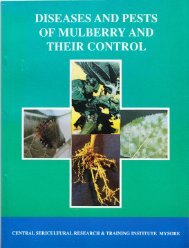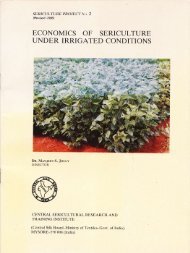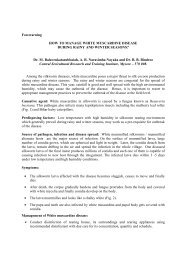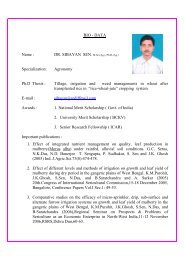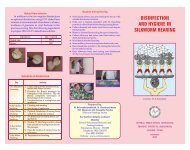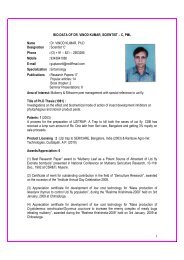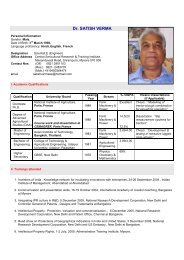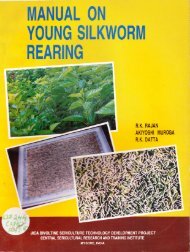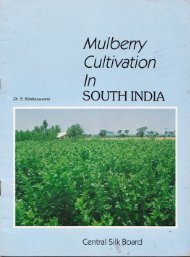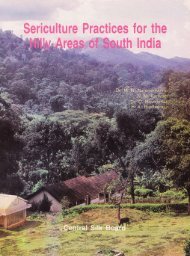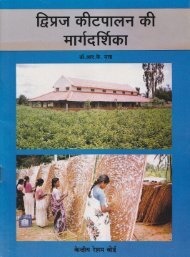E}A]\GALORE
Improved Method Rearing Younf Age (Young) Silkworms - Central ...
Improved Method Rearing Younf Age (Young) Silkworms - Central ...
- No tags were found...
Create successful ePaper yourself
Turn your PDF publications into a flip-book with our unique Google optimized e-Paper software.
250-g0O layings at a time, 25 to 30 trays will be required to do the chawki reartng.<br />
ln the case of dry garden, the requirement will be about 10 trays which will suffice to<br />
do the chawki rearing, upto 100 layings at a time'<br />
ln addition to trays, stands or racks are also required so that the trays containing<br />
worms which are normally kept piled up one over the other, may be spread out on the<br />
stands for short periods for necessary drying of the beds prior to each feeding' A bench<br />
is also required which is used as the base for piling up the trays.<br />
The rearing stands meant for normal rearing of late age worms may be used for<br />
spreading the trays for drying purposes. ln the case of Government owned or assisted<br />
chawki rearing centres or community chawki rearing centres, where a large quantity<br />
of eggs is brushed for young age rearing and distribution of chawki worms to the<br />
sericulturists later, it is important that they are properly equipped as indicated above<br />
to ensure eflicient working and production of good results'<br />
B. Rearing Room SPace:<br />
lf one can afford, it is always desirable and convenient to have a separate<br />
chawki rearing room or house, so that chances of contamination from the debris of the<br />
main rearing house, where the diseases normally manifest themselves, are kept at<br />
minimum. lt will also facilitate easy disinfection of the chawki rearing house as and<br />
when required, quite independently of the main rearing house. Further, the space<br />
required lor young age rearing being comparatively smaller and limited, the desired<br />
temperature level for the young age worms could be easily attained and maintained<br />
even in cold weather.<br />
The rearing room space required for young age rearing will depend on the area<br />
of the mutberry field and its leaf yielding capaciiy. From one acre of irrigated garden,<br />
that is cultivated on scientilic lines as recommended in Bulletin No. 1 of the lnstitute,<br />
it is possible to get upto'10 to 12 thousand kg. of quality leaf per acre per annum' with<br />
these, as many as 1,250 to 1,400 layings can be reared, the leaf used being at the<br />
rate of 800 to 850 kg. for every 100 layings as recommended in Bulletin No' 2 of the<br />
lnstitute. This would mean that on dn average 250 to 300 layings can be reared at a<br />
time per rearing, out of the five rea:'ings in all that can be taken lrom an acre' On the<br />
basis of above reckoning, chawki room space required for an acre ol irrigated mulberry<br />
garden is about 10'x1i'o, 120 sq. ft' which is needed to accommodate about 30<br />
trays, one stand or rack and a bench.<br />
The rearing room should have optimum sized windows with shutters provided,<br />
preferably on all sides of the room, so that inside ventilation could be manipulated as<br />
required.<br />
The rack and the trays may be arranged in the (10'x12') room as indicated in<br />
Figure 2.


![E}A]\GALORE](https://img.yumpu.com/54052619/8/500x640/eagalore.jpg)

